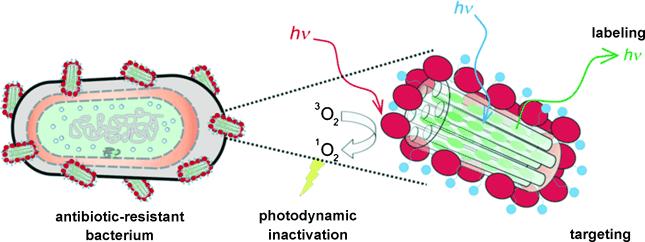 |
Abstract:
Nanoparticles as agents for the photodynamic killing of antibiotic-resistant bacteria
Death by Light
Germany | Posted on October 7th, 2009The increasing antibiotic resistance of bacteria is a serious problem of our time. Hospital germs in particular have developed strains against which practically every current antibiotic is ineffective. In the battle against resistant microbes, a team at the University of Münster (Germany) is now pursuing a new approach involving photodynamic therapy, which is a technique that is already being used in the treatment of certain forms of cancer and macular degeneration. Upon irradiation with light, an agent produces oxygen in a special activated form that is highly toxic to cells. As the researchers led by Cristian A. Strassert and Luisa De Cola report in the journal Angewandte Chemie, they would like to use specially developed nanomaterials that bind specifically to bacterial cells to mark them and kill them under irradiation.
The researchers use nanoparticles made of a special porous material (zeolite L). The particles are modified so they carry a coating of amino groups. These bind preferentially to the surfaces of bacterial cells by means of electrostatic attraction and hydrogen bonds. The researchers put a green fluorescent dye into the channels of the mineral, making the bacteria visible under a fluorescence microscope. The actual "weapons" are photosensitizers anchored on the surface of the nanoparticles. When these molecules are irradiated with light of the right wavelength, they absorb the light energy and transfer it to oxygen molecules found in the surroundings, for example in infected tissue. The oxygen is excited and enters into what is known as the singlet state, in which it is highly reactive and attacks biomolecules - but only in the immediate area in which the singlet oxygen was generated. In this case, the location is right on the bacterial cell where the mineral particle is bound.
The scientists tested their new light-activated killer particles on antibiotic-resistant cultures of E. coli bacteria. After about two hours of irradiation, the bacteria were almost completely killed off. The team achieved comparable results with a strain of resistant gonococci. Furthermore, the researchers from Münster are also considering this material for the treatment of skin cancer. In this case, the tumor cells could be destroyed upon targeted irradiation with red light.
Author: Luisa De Cola, Westfälische Wilhelms-Universität Münster (Germany),
www.uni-muenster.de/Physik.PI/DeCola/ldc.html
Title: Photoactive Hybrid Nanomaterial for Targeting, Labeling, and Killing Antibiotic-Resistant Bacteria
Angewandte Chemie International Edition 2029, 68, No. 42, 7928-7931, doi: 10.1002/anie.200902837
####
For more information, please click here
Contacts:
Editorial office:
or Amy Molnar (US): or Jennifer Beal (UK): or Alina Boey (Asia):
Copyright © Angewandte Chemie
If you have a comment, please Contact us.Issuers of news releases, not 7th Wave, Inc. or Nanotechnology Now, are solely responsible for the accuracy of the content.
| Related News Press |
News and information
![]() Researchers develop molecular qubits that communicate at telecom frequencies October 3rd, 2025
Researchers develop molecular qubits that communicate at telecom frequencies October 3rd, 2025
![]() Next-generation quantum communication October 3rd, 2025
Next-generation quantum communication October 3rd, 2025
![]() "Nanoreactor" cage uses visible light for catalytic and ultra-selective cross-cycloadditions October 3rd, 2025
"Nanoreactor" cage uses visible light for catalytic and ultra-selective cross-cycloadditions October 3rd, 2025
Possible Futures
![]() Spinel-type sulfide semiconductors to operate the next-generation LEDs and solar cells For solar-cell absorbers and green-LED source October 3rd, 2025
Spinel-type sulfide semiconductors to operate the next-generation LEDs and solar cells For solar-cell absorbers and green-LED source October 3rd, 2025
Nanomedicine
![]() New molecular technology targets tumors and simultaneously silences two ‘undruggable’ cancer genes August 8th, 2025
New molecular technology targets tumors and simultaneously silences two ‘undruggable’ cancer genes August 8th, 2025
![]() New imaging approach transforms study of bacterial biofilms August 8th, 2025
New imaging approach transforms study of bacterial biofilms August 8th, 2025
![]() Cambridge chemists discover simple way to build bigger molecules – one carbon at a time June 6th, 2025
Cambridge chemists discover simple way to build bigger molecules – one carbon at a time June 6th, 2025
![]() Electrifying results shed light on graphene foam as a potential material for lab grown cartilage June 6th, 2025
Electrifying results shed light on graphene foam as a potential material for lab grown cartilage June 6th, 2025
Announcements
![]() Rice membrane extracts lithium from brines with greater speed, less waste October 3rd, 2025
Rice membrane extracts lithium from brines with greater speed, less waste October 3rd, 2025
![]() Researchers develop molecular qubits that communicate at telecom frequencies October 3rd, 2025
Researchers develop molecular qubits that communicate at telecom frequencies October 3rd, 2025
![]() Next-generation quantum communication October 3rd, 2025
Next-generation quantum communication October 3rd, 2025
![]() "Nanoreactor" cage uses visible light for catalytic and ultra-selective cross-cycloadditions October 3rd, 2025
"Nanoreactor" cage uses visible light for catalytic and ultra-selective cross-cycloadditions October 3rd, 2025
Nanobiotechnology
![]() New molecular technology targets tumors and simultaneously silences two ‘undruggable’ cancer genes August 8th, 2025
New molecular technology targets tumors and simultaneously silences two ‘undruggable’ cancer genes August 8th, 2025
![]() New imaging approach transforms study of bacterial biofilms August 8th, 2025
New imaging approach transforms study of bacterial biofilms August 8th, 2025
![]() Ben-Gurion University of the Negev researchers several steps closer to harnessing patient's own T-cells to fight off cancer June 6th, 2025
Ben-Gurion University of the Negev researchers several steps closer to harnessing patient's own T-cells to fight off cancer June 6th, 2025
![]() Electrifying results shed light on graphene foam as a potential material for lab grown cartilage June 6th, 2025
Electrifying results shed light on graphene foam as a potential material for lab grown cartilage June 6th, 2025
|
|
||
|
|
||
| The latest news from around the world, FREE | ||
|
|
||
|
|
||
| Premium Products | ||
|
|
||
|
Only the news you want to read!
Learn More |
||
|
|
||
|
Full-service, expert consulting
Learn More |
||
|
|
||








